You're here: Main page > 4. History of Eberswalde's trolleybus system > 4.3. Period from 1966 to 1989
4.3. Period from 1966 to 1989

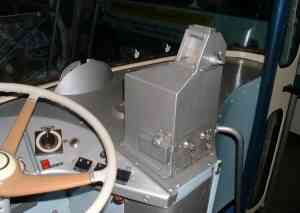 In August 1967 the passenger service systems was adapted to the passenger service systems OS (without conductor)
with slot pay box (Einwurf-Zahlbox) and by the trolleybuses the passenger flow -entrance by the bus driver,
exit at the two rear doors- was introduced.
In August 1967 the passenger service systems was adapted to the passenger service systems OS (without conductor)
with slot pay box (Einwurf-Zahlbox) and by the trolleybuses the passenger flow -entrance by the bus driver,
exit at the two rear doors- was introduced.
At the same time the 10-trips collecting ticket was abolished and replaced by one with 8 trips for adults and with 6 trips
for children. This 8-trips collecting ticket cost 1,- M (M means Mark and the was national currency of the GDR!) for
adults and 0.60 M for children.
That meant also, who had acquired collecting tickets in the advance sale, could drive as an adult for 12 Pfennig (0,12 M) and as a
child for 10 Pfennig (0,10 M). Children, who drove from Nordend to Ostend to the school, tore the single ticket in the
middle through and were able to change therewith. The single tickets of these 6 respectively 8-trips collecting card were
thrown in in the trolleybus into a box near the bus driver and in the trailer into the positioned pay box.
Cash payers used the near the driver or in the trailer positioned pay box.
This system of the bus tickets was used to the 31 August 1985. The fare did not change up to the abolishment of the Mark
of the GDR.
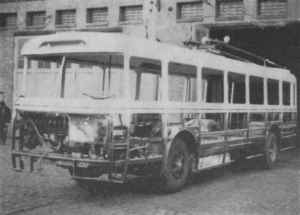 Because the trolleybuses of the Czech types were ŠKODA 8 Tr and ŠKODA 9 Tr after now decennial
expected useful life were strongly in need of repair, one began in the year 1968
in the maintenance workshops with the general overhaul of trolleybuses.
Because the trolleybuses of the Czech types were ŠKODA 8 Tr and ŠKODA 9 Tr after now decennial
expected useful life were strongly in need of repair, one began in the year 1968
in the maintenance workshops with the general overhaul of trolleybuses.
A trolleybus of the Czech type ŠKODA 8 Tr, the car no. 11I, was brought to the overhaul to the public
transportation Dresden and exchanged on the same day against another already general overhauled trolleybus .
In the year 1968 took place also the selection of the last trolleybuses of the GDR type LOWA W 600.
Beginning 1969 further 4 virgin trolleybuses of the Czech type ŠKODA 9 Tr, the trolleybuses no. 16I-
19I, were taken in service by the public transportation. These were brought with the delivered white lacquering into the use. The new trolleybuses were recognizable also by the, on the vehicle roof embarrassed, the braking and driving resistances.
In April 1969 two used trolleybuses of the Czech type ŠKODA 8 Tr were bought by the trolleybus operation Gera. Through the lack of workshop capacity one of both trolleybuses namely trolleybus no. 20I
was first in March 1970 placed into service. The other trolleybus from Gera, planned as trolleybus no. 21I,
served as a spare part dispenser and was finally scrapped.
Beginning 1970 further 4 virgin trolleybuses of the Czech type ŠKODA 9 Tr, the trolleybuses no. 22I-25I
, were taken in service. Six months later once more two trolleybuses of the Czech type ŠKODA 9 Tr, the
trolleybuses no. 26I und 27I, were taken in service. This were the last vehicle supply from
trolleybuses until the year 1984.
The last 6 delivered trolleybuses had already no more hitches. Trolleybus-trailer combinations were only used starting
from September 1970 in the rush-hour traffic for reinforcement. In the population this trolleybus-trailer combinations was
named " Einsetzer" (Initiationer).
The green-white colouring of the other trolleybuses were replaced starting from 1970 by a ivory-coloured lacquering.
The changes in the administration structure of the city, the merging of the cities Eberswalde and Finow,
influenced not unessential the affiliation of the municipal VEB Verkehrsbetriebe Eberswalde to the VEB Kraftverkehr
Eberswalde-Finow on 01 January 1970 as plant section IV. The company VEB Kraftverkehr Eberswalde-Finow was a nationally
owned enterprise for transportation of cargo and public transport.
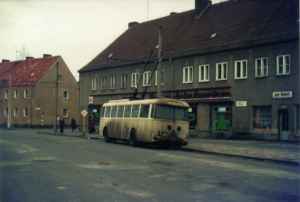 End of the sixties, at the beginning of the seventies was in Nordend the industrial area extended. For it became between
Angermünder Chaussee (simultaneously long distance traffic road no. 2) and Poratzstraße a road connection created,
the Industriestraße (today: Neue Straße). A better transport connexion of the
industrial area Nordend to the public local passenger traffic made itself necessary.
End of the sixties, at the beginning of the seventies was in Nordend the industrial area extended. For it became between
Angermünder Chaussee (simultaneously long distance traffic road no. 2) and Poratzstraße a road connection created,
the Industriestraße (today: Neue Straße). A better transport connexion of the
industrial area Nordend to the public local passenger traffic made itself necessary.
On 07 October 1973 was inaugurated for a better traffic development a new single-lane distance, Straße der Jugend-
Industriestraße(today: Neue Straße)-Poratzstraße, in Nordend. The new building distance had a length of
1,9 km. The length of the line Westend-Nordend amounts to now 5,2 km.
To the turn of the year 1972/73 two trolleybuses of the Czech type ŠKODA 9 Tr were transferred from Berlin to
Eberswalde. These two 1964 and 1965 built trolleybuses came in use in Eberswalde in January 1973 with the car numbers
28I and 29I.
End of the 70's prepared the maintenance of trolleybus traffic in nearly all cities of the GDR substantial problems. An
outdated vehicle fleet were maintained technically ready for operation and as 1975 the spare part supply completely was
missing, had some cities to stop their trolleybus traffic.
_01k_811123.jpg) After the trolleybus operation in Dresden /GDR had been stopped on 28 November 1975, the Eberswalde trolleybus operation received end 1975 three trolleybuses of the Czech type ŠKODA 9 Tr13 from Dresden.
After the trolleybus operation in Dresden /GDR had been stopped on 28 November 1975, the Eberswalde trolleybus operation received end 1975 three trolleybuses of the Czech type ŠKODA 9 Tr13 from Dresden.
With the trolleybuses also five trailers of the type W 701-Reko were transferred to Eberswalde. These
trailers received the car numbers XIV to XVIII. Since these trailers had been overhauled between June 1969 and September
1971 in the motor vehicle repair enterprise Altenburg/GDR and so that had a good technical condition, not reconstructed
trailers could be scrapped in 1976.
The electric rectifier substation (today: GUW Mitte) was reconstructed and extended in 1975.
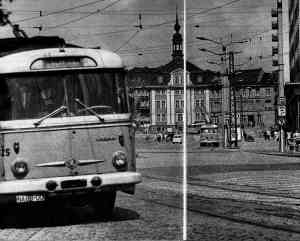 In September 1977 Eberswalde received three trolleybuses of the Czech type the ŠKODA
9 Tr from Gera /GDR, because there on the 14 September 1977 the trolleybus operation was stopped.
In September 1977 Eberswalde received three trolleybuses of the Czech type the ŠKODA
9 Tr from Gera /GDR, because there on the 14 September 1977 the trolleybus operation was stopped.
In the year 1978 the full automation of the electric rectifier substation, the today's electric rectifier substation Mitte (GUW Mitte), was concluded. In the same year the first electrical switch was built into the trolleybus overhead line system at the Karl-Marx-Platz. It was developed by the chief of the rationalization means building of the motor traffic enterprise, Mr. Ing. H. Vetter, under participation of its co-workers and also manufactured. In the year 1980 a second electrical switch was built in at the Platz der Freundschaft (today: Markt).
The end of the seventies beginning world-wide oil crisis and the therewith involved enormous rise in prices of the crude oil favoured the decisions for the receipt of the trolleybuses in the German Democratic Republic (GDR). Through use of
domestic brown coal for generation of electricity could the German Democratic Republic (GDR) save foreign exchange. The
electrical vehicle drive was at one time again a means for rational use of energy, for the saving of crude oil and thus in the long run from foreign exchange.
On 18 September 1980 the Council of Ministers of the German Democratic Republic (GDR) made a decision to comprehensive measures for rational use of energy. By this decision also the receipt of the existing trolleybus operations should become secured.
From the eleven trolleybus operation systems in the GDR only three withstood the strong economic pressure, Potsdam, Weimar and Eberswalde-Finow. Increasingly headache prepared 1980 in the meantime the completely worn rolling stock in Weimar and Potsdam. The Eberswalde trollleybuses could be further used owing to a careful maintenance. It were many efforts, much optimism and imagination as well as a high operational readiness, particularly of the technicians and maintenance engineers, necessary, to fulfil over - temporarily as only trolleybus operating enterprise in the GDR - in its entirety the functions in inner-city traffic. The supply of new vehicles, as far as possible articulated trolleybuses, were urgently necessary in Eberswalde. Due to the missing supply of new vehicles the trolleybus operation system in Eberswalde was occasionally threatened from deactivation. So should be operated the line Ostend - Westend completely with Diesel buses starting from the end of 1979.
In the year 1983 the rolling stock consisted of one trolleybus of the Czech type ŠKODA 8 Tr and 15 trolleybuses of the Czech type ŠKODA 9 Tr. For the first time since 1975 also again took place the spare parts supplies for the trolleybuses.
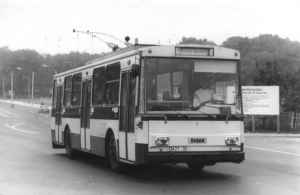 In the year 1983 the Czech trolleybus producer ŠKODA offered the ministry for foreign trade of the GDR virgin trolleybuses of the Czech type ŠKODA 14 Tr03 . After an 14 year-old interruption Eberswalde received for the first time again 3 new vehicles on 06 January 1984. The trolleybuses
received the car numbers 1IV to 3IV. Starting from 14 February 1984 the three new vehicles were taken in service in the Eberswalde line operation.
In the year 1983 the Czech trolleybus producer ŠKODA offered the ministry for foreign trade of the GDR virgin trolleybuses of the Czech type ŠKODA 14 Tr03 . After an 14 year-old interruption Eberswalde received for the first time again 3 new vehicles on 06 January 1984. The trolleybuses
received the car numbers 1IV to 3IV. Starting from 14 February 1984 the three new vehicles were taken in service in the Eberswalde line operation.
In April 1984 the last trolleybus of the Czech type ŠKODA 8 Tr was taken out of service in Eberswalde.
On 25 August 1984 its scrapping took place.
On 06 June 1984 the car numbers and licence plate numbers of the trolleybuses No. 18I and 30I and on 25 August 1984 of the trolleybuses No. 19I and 31I were changed for accounting department reasons. In the socialist planned economy only vehicles could be scrapped, which have no more amortised cost.
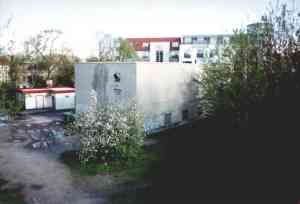 For the accomplishment of the enormous rush-hour traffic in Eberswalde trolleybuses with trailers were necessary, which were only allowed to operate due to a special permit. In order to ensure the permanently growing transport need were also into Eberswalde large room vehicles necessary for the conveyance of passengers. The Hungarian Ikarus factory Budapest/Hungary offered the GDR at the beginning of the eighties trolleybuses of the type Ikarus 280.93 on the basis of the at that time already well-known articulated Diesel bus Ikarus 280. The foreign trade of the GDR bought 150 vehicles of this type.
For the accomplishment of the enormous rush-hour traffic in Eberswalde trolleybuses with trailers were necessary, which were only allowed to operate due to a special permit. In order to ensure the permanently growing transport need were also into Eberswalde large room vehicles necessary for the conveyance of passengers. The Hungarian Ikarus factory Budapest/Hungary offered the GDR at the beginning of the eighties trolleybuses of the type Ikarus 280.93 on the basis of the at that time already well-known articulated Diesel bus Ikarus 280. The foreign trade of the GDR bought 150 vehicles of this type.
In preparation of the delivery of articulated trolleybuses of the Hungarian type Ikarus 280.93, which had due to their technical data (in particular high start-up acceleration) very high requirements of electric current, the electric rectifier substation east (GUW Ost) was planned and built at the Friedensbrücke.
In June 1985 the new electric rectifier substation east (GUW Ost) near the Friedensbrücke
was connected to.
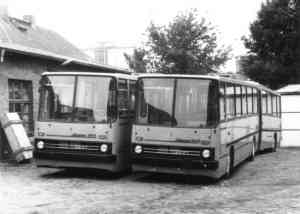 In June 1985 the first seven articulated trolleybuses of the Hungarian type Ikarus 280.93 were delivered to Eberswalde.
In June 1985 the first seven articulated trolleybuses of the Hungarian type Ikarus 280.93 were delivered to Eberswalde.
After the first articulated trolleybuses of the Hungarian type Ikarus 280.93 had arrived and their use was foreseeable, the use of bus trailers were stopped with beginning of the long vacation on 04 July 1985 after approximately 42 years.
From the beginning of August 1985 the first trolleybuses of the Hungarian type Ikarus 280.93 were used. At the same time with the use of the new trolleybuses new perforation ticket validators were introduced for the passenger dispatch and for cash payers was a pay box situated opposite the second door.
Already in the seventies the housing area "Max Reimann" was constructed south of the Eisenspalterei, between Eberswalde and Finow. Due to the industrial construction method (building made with precast concrete slabs) it was built on the so-called "green grassland", also in the open countryside. Through party congress resolutions of the Socialist Unity Party of Germany (SED), in which the "solution of the housing problem as social problem until 1990" was announced, took place a ever further development of this housing area. This further development let the need of transport strongly rise. After already in 1980 a bus line, which was operated with motor-buses, had been disposed, the councel of the district Frankfurt/Oder decided the extension of the Eberswalde trolley system into the housing area "Max Reimann" and after Finow on 26 September 1985.
The trolleybuses no. 1IV to 3IV of the Czech type ŠKODA 14Tr03 received beginning of 1986 due to strong rust damage at the car body's a new green-white lacquering.
In the year 1986 were 6 further articulated trolleybuses of the Hungarian type Ikarus 280.93 delivered to Eberswalde.
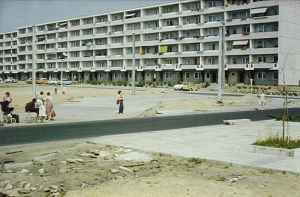 In the year 1986 began the construction work for the extension of the Eberswalde trolley system into the housing area "Max Reimann".
In the year 1986 began the construction work for the extension of the Eberswalde trolley system into the housing area "Max Reimann".
The use of the articulated trolleybuses of the Hungarian type Ikarus 280.93 meant a substantial need of traction current.
Because the building of the electric rectifier substation west (GUW west) was delayed, a mobile electric rectifier substation was acquired. Starting from 20 July 1987 a experimental supply into the overhead line system took place at the Anton-Saefkow-Straße.
During the reconstruction of the electric rectifier substation center (GUW Mitte) in the year 1987 the mobile electric rectifier substation supplied the traction current into the overhead line system. The mercury arc rectifiers were replaced during the reconstruction.
In preparation for the opening of the trolleybus line to the housing area "Max Reimann" and the increased vehicle need respectively 2 trolleybuses of the Hungarian type Ikarus 280.93 were transferred from the trolleybus operation Potsdam/GDR and Weimar/GDR end of October/at the beginning of November 1987. They received the car numbers 17II, 18III, 19III and 20II. The trolleybuses of the Czech type ŠKODA 9 Tr except for 2 vehicles were deactivated.
The depot Eberswalde/Anton-Saefkow-Straße (today: Bergerstraße) offered in the meantime for the entire vehicle fleet only insufficient place. In order to correct this shortage of space, a public parking place at the corner Anton-Saefkow-Straße/Zimmerstraße became closed and served from now on as parking place for the trolleybuses.
On 06 November 1987 took place the inauguration of the new trolleybus line (length 3,1 km) from Westend to the housing area "Max Reimann", today "Brandenburgisches Viertel". The regular transport service is taken up on 08 November 1987 at the operation start. The trolleybus operation system comprises now the line S 1 WK "Max Reimann"-Nordend and the line S 2 Westend-Ostend . As a result of the enormous passenger quantity in the housing area "Max Reimann" was driven in the morning rush-hour traffic at 6 minute intervals and partly even at 4 minute intervals. At this opportunity also the slot pay boxes, which afforded numerous opportunities for manipulation by the passengers, were abolished.
dannw30(II)+wzxy_05k_schrott_ma9203.jpg) The last trolleybuses of the Czech type ŠKODA 9 Tr , car numbers 27I and 29I), were
taken out of service in Eberswalde on 20 January 1988. In February 1988 drove the trolleybus no. 32I of the Czech type ŠKODA 9 Tr, which was already taken out of service on 26 October 1987, the last use of a trolleybus of the Czech type ŠKODA 9 Tr in the German Democratic Republic (GDR).
The disused trolleybuses of the Czech type ŠKODA 9 Tr were parked at the VEB Kraftverkehr Eberswalde-Finow. The scrapping took place in the year 1992. Two trolleybuses were used as stockrooms. The trolleybus no. 31II was tranferred from trolleybus friends of the German Model Railway Association (Deutschen Modelleisenbahn-Verband) to Berlin to the tram depot Niederschönhausen on 22 December 1988 and received as technical monument.
The last trolleybuses of the Czech type ŠKODA 9 Tr , car numbers 27I and 29I), were
taken out of service in Eberswalde on 20 January 1988. In February 1988 drove the trolleybus no. 32I of the Czech type ŠKODA 9 Tr, which was already taken out of service on 26 October 1987, the last use of a trolleybus of the Czech type ŠKODA 9 Tr in the German Democratic Republic (GDR).
The disused trolleybuses of the Czech type ŠKODA 9 Tr were parked at the VEB Kraftverkehr Eberswalde-Finow. The scrapping took place in the year 1992. Two trolleybuses were used as stockrooms. The trolleybus no. 31II was tranferred from trolleybus friends of the German Model Railway Association (Deutschen Modelleisenbahn-Verband) to Berlin to the tram depot Niederschönhausen on 22 December 1988 and received as technical monument.
The construction work at the second phase of construction to Finow began in spring 1989 with delay. As a result of missing construction capacity became the second phase of construction divided into two subsections. One wanted in honours of the 40 Anniversary of the German Democratic Republic (GDR) on 07 October 1989 at least finish the first subsection from the crossing Spechtausener Straße/Leninstraße to Kleinen Stern.
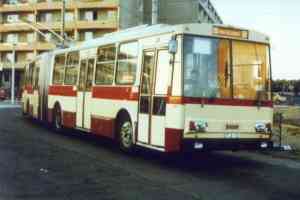 It came to nothing as a result of further construction delays.
It came to nothing as a result of further construction delays.
The company VEB Technische Gebäudeausrüstung Hennickendorf, plant section Eberswalde (Technical Building Equipment) began on 17 July 1989 with the assembly of the electric rectifier substation west (GUW west) at Forsthaus in the quarter Finow. Also the planned parking area was begun.
In the summer 1989 the Eberswalde trolleybus operation received the possibility to test an articulated trolleybus of the Czech type ŠKODA 15 Tr. The articulated trolleybus was from 24 July 1989 to 07 November 1989 in Eberswalde.
By a peaceful revolution in November 1989 by the people of the German Democratic Republic (GDR) was the reunification of Germany initiated. In the future should with it important changes in politics and economics involved. These changes affected naturally also the trolleybus operation.
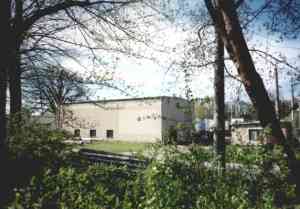
End of December 1989 the electric rectifier substation west (GUW West) at Forsthaus in the quarter Finow was taken in service. Thus the mobile rectifier substation could be taken out of service, which in the meantime already supplied traction current to the trolleybus overhead system for the connection of the housing area "Max Reimann".
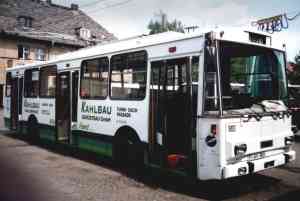
In foresight of the opening of parts from the second construction phase of the trolleybus net expansion and in the context of a vehicle type clearance of the rolling stock the trolleybuses no. 1IV to 3IV of the Czech type ŠKODA 14 Tr were transferred from Eberswalde to Potsdam in December 1989. From Potsdam came there for the 3 remaining articulated trolleybuses of the Hungarian type Ikarus 280.93, car no. 951 to 953, to Eberswalde.

 In August 1967 the passenger service systems was adapted to the passenger service systems OS (without conductor)
with slot pay box (Einwurf-Zahlbox) and by the trolleybuses the passenger flow -entrance by the bus driver,
exit at the two rear doors- was introduced.
In August 1967 the passenger service systems was adapted to the passenger service systems OS (without conductor)
with slot pay box (Einwurf-Zahlbox) and by the trolleybuses the passenger flow -entrance by the bus driver,
exit at the two rear doors- was introduced.
 Because the trolleybuses of the Czech types were ŠKODA 8 Tr and ŠKODA 9 Tr after now decennial
expected useful life were strongly in need of repair, one began in the year 1968
in the maintenance workshops with the general overhaul of trolleybuses.
Because the trolleybuses of the Czech types were ŠKODA 8 Tr and ŠKODA 9 Tr after now decennial
expected useful life were strongly in need of repair, one began in the year 1968
in the maintenance workshops with the general overhaul of trolleybuses.
 End of the sixties, at the beginning of the seventies was in Nordend the industrial area extended. For it became between
Angermünder Chaussee (simultaneously long distance traffic road no. 2) and Poratzstraße a road connection created,
the Industriestraße (today: Neue Straße). A better transport connexion of the
industrial area Nordend to the public local passenger traffic made itself necessary.
End of the sixties, at the beginning of the seventies was in Nordend the industrial area extended. For it became between
Angermünder Chaussee (simultaneously long distance traffic road no. 2) and Poratzstraße a road connection created,
the Industriestraße (today: Neue Straße). A better transport connexion of the
industrial area Nordend to the public local passenger traffic made itself necessary.
_01k_811123.jpg) After the trolleybus operation in Dresden /GDR had been stopped on 28 November 1975, the Eberswalde trolleybus operation received end 1975 three trolleybuses of the Czech type ŠKODA 9 Tr13 from Dresden.
After the trolleybus operation in Dresden /GDR had been stopped on 28 November 1975, the Eberswalde trolleybus operation received end 1975 three trolleybuses of the Czech type ŠKODA 9 Tr13 from Dresden.
 In September 1977 Eberswalde received three trolleybuses of the Czech type the ŠKODA
9 Tr from Gera /GDR, because there on the 14 September 1977 the trolleybus operation was stopped.
In September 1977 Eberswalde received three trolleybuses of the Czech type the ŠKODA
9 Tr from Gera /GDR, because there on the 14 September 1977 the trolleybus operation was stopped.
 In the year 1983 the Czech trolleybus producer ŠKODA offered the ministry for foreign trade of the GDR virgin trolleybuses of the Czech type ŠKODA 14 Tr03 . After an 14 year-old interruption Eberswalde received for the first time again 3 new vehicles on 06 January 1984. The trolleybuses
received the car numbers 1IV to 3IV. Starting from 14 February 1984 the three new vehicles were taken in service in the Eberswalde line operation.
In the year 1983 the Czech trolleybus producer ŠKODA offered the ministry for foreign trade of the GDR virgin trolleybuses of the Czech type ŠKODA 14 Tr03 . After an 14 year-old interruption Eberswalde received for the first time again 3 new vehicles on 06 January 1984. The trolleybuses
received the car numbers 1IV to 3IV. Starting from 14 February 1984 the three new vehicles were taken in service in the Eberswalde line operation.
 For the accomplishment of the enormous rush-hour traffic in Eberswalde trolleybuses with trailers were necessary, which were only allowed to operate due to a special permit. In order to ensure the permanently growing transport need were also into Eberswalde large room vehicles necessary for the conveyance of passengers. The Hungarian Ikarus factory Budapest/Hungary offered the GDR at the beginning of the eighties trolleybuses of the type Ikarus 280.93 on the basis of the at that time already well-known articulated Diesel bus Ikarus 280. The foreign trade of the GDR bought 150 vehicles of this type.
For the accomplishment of the enormous rush-hour traffic in Eberswalde trolleybuses with trailers were necessary, which were only allowed to operate due to a special permit. In order to ensure the permanently growing transport need were also into Eberswalde large room vehicles necessary for the conveyance of passengers. The Hungarian Ikarus factory Budapest/Hungary offered the GDR at the beginning of the eighties trolleybuses of the type Ikarus 280.93 on the basis of the at that time already well-known articulated Diesel bus Ikarus 280. The foreign trade of the GDR bought 150 vehicles of this type.
 In June 1985 the first seven articulated trolleybuses of the Hungarian type Ikarus 280.93 were delivered to Eberswalde.
In June 1985 the first seven articulated trolleybuses of the Hungarian type Ikarus 280.93 were delivered to Eberswalde.
 In the year 1986 began the construction work for the extension of the Eberswalde trolley system into the housing area "Max Reimann".
In the year 1986 began the construction work for the extension of the Eberswalde trolley system into the housing area "Max Reimann".
dannw30(II)+wzxy_05k_schrott_ma9203.jpg) The last trolleybuses of the Czech type ŠKODA 9 Tr , car numbers 27I and 29I), were
taken out of service in Eberswalde on 20 January 1988. In February 1988 drove the trolleybus no. 32I of the Czech type ŠKODA 9 Tr, which was already taken out of service on 26 October 1987, the last use of a trolleybus of the Czech type ŠKODA 9 Tr in the German Democratic Republic (GDR).
The disused trolleybuses of the Czech type ŠKODA 9 Tr were parked at the VEB Kraftverkehr Eberswalde-Finow. The scrapping took place in the year 1992. Two trolleybuses were used as stockrooms. The trolleybus no. 31II was tranferred from trolleybus friends of the German Model Railway Association (Deutschen Modelleisenbahn-Verband) to Berlin to the tram depot Niederschönhausen on 22 December 1988 and received as technical monument.
The last trolleybuses of the Czech type ŠKODA 9 Tr , car numbers 27I and 29I), were
taken out of service in Eberswalde on 20 January 1988. In February 1988 drove the trolleybus no. 32I of the Czech type ŠKODA 9 Tr, which was already taken out of service on 26 October 1987, the last use of a trolleybus of the Czech type ŠKODA 9 Tr in the German Democratic Republic (GDR).
The disused trolleybuses of the Czech type ŠKODA 9 Tr were parked at the VEB Kraftverkehr Eberswalde-Finow. The scrapping took place in the year 1992. Two trolleybuses were used as stockrooms. The trolleybus no. 31II was tranferred from trolleybus friends of the German Model Railway Association (Deutschen Modelleisenbahn-Verband) to Berlin to the tram depot Niederschönhausen on 22 December 1988 and received as technical monument.
 It came to nothing as a result of further construction delays.
It came to nothing as a result of further construction delays.

